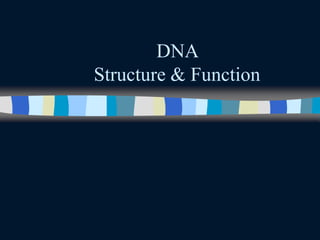
Dna
- 2. Key terms Genome = complete set of sequences in the genetic material of an org. Nucleic acids = Macromolecules (large RMM). Chromosomes = Discrete unit of the genome carrying many genes. NA and protein. Gene = Segment of DNA specifying production of a polypeptide chain. It codes for a RNA protein.
- 3. • Genotypic = Replication. Store &transmit info. • Phenotypic = Gene expression. Control devlp of phenotype. • Evolutionary = Mutation. Changes produce variations. Fx…..preserving, copying and transmitting information.
- 4. Chromosomes composed of 2 macmol. i. Protein. ii. Nucleic acids DNA(d) and RNA(s)
- 5. Structure of nucleotides.. A ) 5 carbon pentose sugar ; RNA = Ribose, DNA = Deoxyribose. b) A nitrogen containing base; 2 Purines (A,G) 2 Pyrimidines (C,T/U) RNA = CGAU, DNA = CGAT c) A phosphate group
- 10. Watson and Crick’s model double helix sugar-phosphate backbone = sugar is deoxyribose 4 types of nucleotide base : A, C, G, T : 2 complementary strands where A = T, C = G in anti parallel fashion – "complementary“ = fitting together of 2 molecules with hydrogen bonds
- 12. Phosphodiester bonds.. A dinucleotide is formed when a condensation reaction occurs between the phosphate group of one nucleotide and pentose of another forming a phosphodiester bridge linking the 2 nucleotides together.
- 13. More nucleotides can be added, building up a long polynucleotide chain.
- 14. The stability of the double helix is due to the large number of covalent, H+ and hydrophobic bonds.
- 17. Double Helix.. Uprights = Sugar phosphate bond, Rungs = Bases (A+T/G+C) 2 strands running in opposite direction (5’ – 3’) <>
- 20. Genetic code These bases always pair up in the same way. A single strand of DNA is made of letters: ATGCTCGAATAAATG The letters make words: ATG CTC GAA TAA ATG TGA ATT TGA The words make sentences: <ATG CTC GAA TAA> <ATG TGAATT TGA> These "sentences" are called genes
- 21. Genetic code The instructions in a gene that tell the cell how to make a specific protein. A, T, G, and C. 3 letter word = codon = Triplet code. Fx of codon = tell the cell how to make proteins Start and stop codon.
- 22. Genetic code contd.. Inside the nucleus, the DNA message is copied onto RNA. to transmit the message or genetic code. It has 4 subunits A, T, G, C and are arranged in triplet codes. Eg ATTGCCTAG read from left to right ATT/GCC/TAG. Each triplet code specifies different amino acids. Eg. ATT = amino acid “X” GCC = amino acid “Y” TAG = amino acid “Z” This piece of genetic code will instruct the cell to make a protein in which X,Y and Z are joined together in that order.
